The great Indian bustard (Ardeotis nigriceps) is one of the heaviest flying birds and a critically endangered species native to the dry grasslands of India and Pakistan. Once widespread, its population has plummeted to fewer than 200 individuals due to habitat loss, hunting, and human encroachment. Conservation efforts are underway, but the species remains on the brink of extinction.
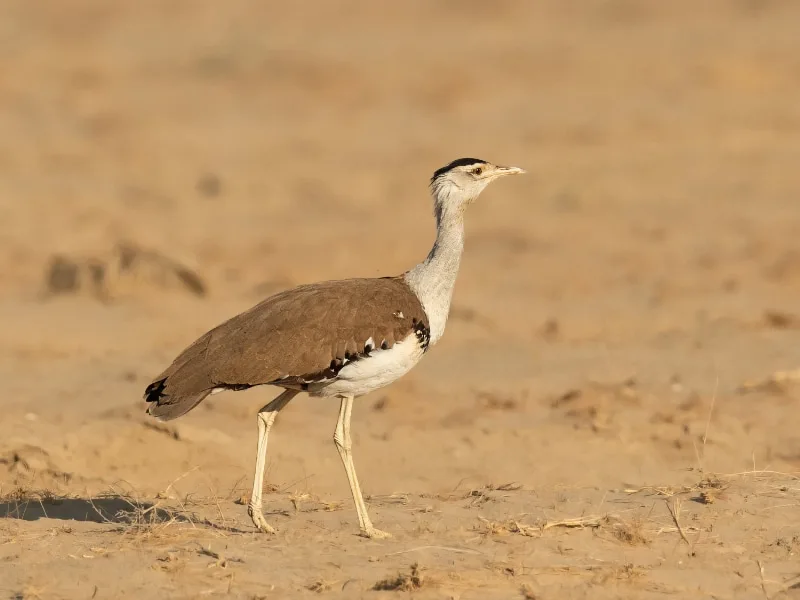
| Common name | Great Indian bustard |
| Scientific name | Ardeotis nigriceps |
| Alternative name | Indian bustard |
| Order | Otidiformes |
| Family | Otididae |
| Genus | Ardeotis |
| Identification | Large brown-and-white bustard with a black crown and wing markings |
| Lifespan | 12-15 years in the wild |
| Range | India (Rajasthan, Gujarat, Maharashtra, Karnataka, Andhra Pradesh), Pakistan (Sindh) |
| Migration | Largely sedentary, with some local movements |
| Habitat | Arid grasslands, dry scrubland, semi-desert regions |
| Diet | Insects, small vertebrates, seeds, and grasses |
| Conservation status | Critically Endangered |
Discovery
The great Indian bustard (Ardeotis nigriceps) was first described scientifically by Irish zoologist Nicholas Aylward Vigors in 1831. Vigors, a co-founder of the Zoological Society of London, assigned the species its binomial name, highlighting its distinct black crown – “nigriceps” deriving from Latin for “black-headed.”
Prior to Vigors’ formal description, the species was known to indigenous communities across the Indian subcontinent, featuring in local folklore and traditional knowledge. Early European naturalists and colonial administrators documented the bird in the 19th and early 20th centuries. Notably, in Stray Feathers (1881), F. Wilson reported observing flocks in Uttar Pradesh, and ornithologist E. C. Stuart Baker detailed its distribution and habits in The Game Birds of India, Burmah, and Ceylon (1921).
Taxonomically, the great Indian bustard belongs to the order Otidiformes and the family Otididae, which encompasses all bustard species. However, it was historically classified under the order Gruiformes, alongside cranes and rails. Advances in molecular phylogenetics later confirmed that bustards are evolutionarily distinct, leading to their reclassification into Otidiformes, a separate order dedicated exclusively to bustards.
Within the genus Ardeotis, the Great Indian Bustard is closely related to species such as the kori bustard (Ardeotis kori) of Africa and the Australian bustard (Ardeotis australis). The species is monotypic, meaning no subspecies have been described.
Identification
The great Indian bustard is one of the heaviest flying birds, with males standing at about 1 meter (3.3 feet) tall and females slightly shorter. Males typically weigh between 8 to 14.5 kilograms (17.6 to 32 pounds), while females are lighter, ranging from 2.5 to 6.75 kilograms (5.5 to 14.9 pounds). The wingspan of this species is approximately 2.1 to 2.5 meters (6.9 to 8.2 feet), facilitating strong flight capabilities despite their substantial size.
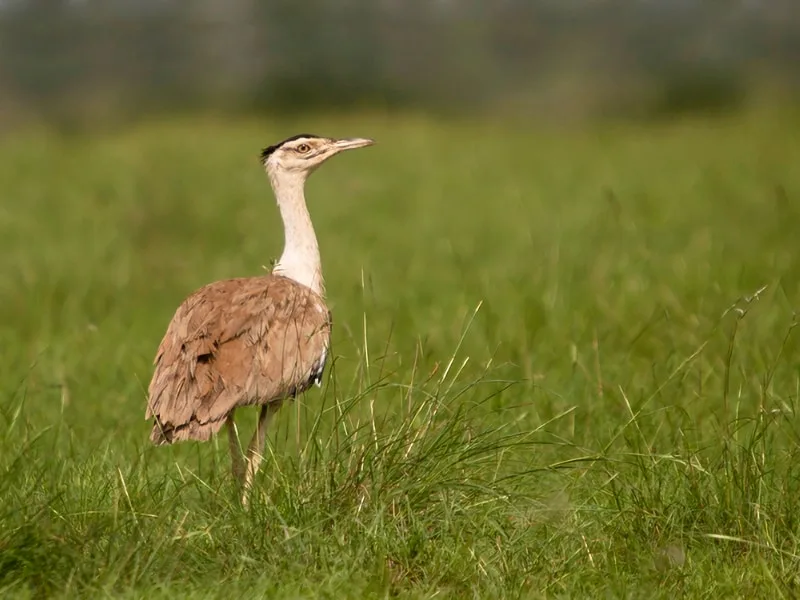
Males are characterized by striking white underparts, a black crown, and a narrow black breast-band. Females are smaller, with a greyer neck and usually lack the breast-band. Juveniles resemble adult females but display duller plumage.
Vocalization
Generally silent, males produce a deep, resonant booming call during the breeding season to attract mates. This call can be heard up to 500 meters away. Occasional low grunts and alarm calls have also been recorded.
Range
The great Indian bustard was once found across most of the Indian subcontinent but is now restricted to a few fragmented populations. Historically, it was recorded across India, Pakistan, and possibly extending into Nepal, but habitat destruction and hunting have led to its near-total disappearance from much of its former range.
The largest surviving population is found in Rajasthan, particularly in and around Desert National Park, spanning Jaisalmer and Barmer districts. Small, scattered groups persist in Gujarat, Maharashtra, Karnataka, and Andhra Pradesh, though their numbers are critically low. Reports suggest that the species has been lost from much of its former range in Madhya Pradesh, Uttar Pradesh, and Tamil Nadu.
In Pakistan, the great Indian bustard was once found in Sindh and Punjab, but it is now presumed extinct in most regions. However, occasional sightings have been reported from the Cholistan Desert, suggesting that a few individuals may still exist in isolated pockets.
Migration
The great Indian bustard is largely sedentary, with most individuals remaining within their home range throughout the year. However, some seasonal movements have been observed, particularly in response to food availability and breeding conditions. In Rajasthan and Gujarat, individuals are known to shift between feeding and nesting grounds depending on the season.
There is also limited evidence suggesting possible cross-border movements between India and Pakistan, particularly in the Thar and Cholistan Deserts. However, habitat fragmentation and human encroachment have likely restricted these movements compared to historical patterns. Conservationists emphasize that securing and restoring habitat corridors is crucial to ensuring the species’ survival, allowing for natural movements that were once essential for its life cycle.
Habitat
The species inhabits open, dry grasslands, semi-arid scrublands, and lightly grazed pastures, avoiding densely vegetated areas and wetlands. It thrives in landscapes with low shrub cover and sparse tree density, relying on its excellent camouflage to evade predators.
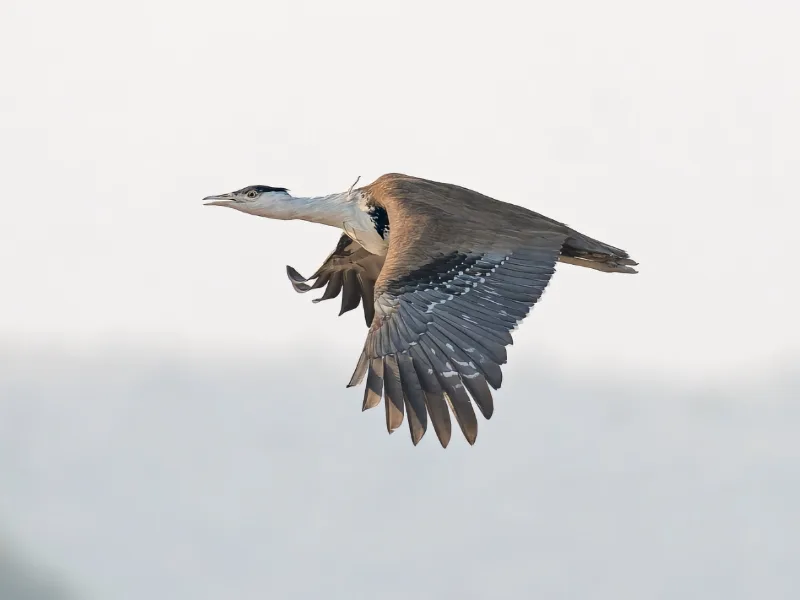
Unlike some grassland birds that adapt to human-altered landscapes, the great Indian bustard is highly sensitive to habitat disturbance, particularly the conversion of native grasslands into agricultural fields, infrastructure projects, and industrial zones. Overgrazing by livestock and habitat fragmentation further threaten the already dwindling populations, leaving the species with fewer undisturbed areas to breed and forage.
Behavior
The great Indian bustard is a terrestrial and diurnal species, spending most of its day walking through grasslands in search of food. It relies heavily on its camouflage to evade predators, preferring to crouch and remain motionless rather than taking flight. Historically, it was observed in large flocks, but due to severe population declines, it is now mostly found alone or in small groups.
Foraging primarily takes place in the early morning and late afternoon, with the bird consuming a mix of insects, small vertebrates, seeds, and grasses. It shares its habitat with species such as chinkara and blackbuck, but its primary threats come from predators like foxes, feral dogs, and birds of prey, particularly for eggs and chicks.
Breeding
Breeding occurs primarily during the monsoon season (July-September), when males engage in elaborate courtship displays. These displays include inflating a throat sac and producing deep, booming calls to attract females. The species follows a lek mating system, where males gather in display areas while females choose their mates. After mating, the female lays a single egg directly on the ground without constructing a nest. Incubation lasts about 21 days, and the female alone cares for the chick. Hatchlings are highly vulnerable to predation and human disturbances.
In recent years, conservation efforts have introduced captive breeding programs, particularly in Rajasthan, where eggs are incubated and reared under controlled conditions. While some chicks have been successfully hatched, the long-term success of reintroducing them into the wild remains uncertain due to habitat loss and other environmental challenges.
Lifespan
The estimated lifespan of the great Indian bustard in the wild is 12-15 years, though many individuals do not reach this age due to high mortality rates from habitat destruction, predation, and human-related threats. In captivity, with controlled diets and protection from predators, bustards may live longer, but successful long-term captive management remains a challenge. The ultimate goal of conservation efforts is to restore wild populations, as captive breeding alone cannot ensure the survival of the species without adequate habitat protection.
Diet
The great Indian bustard has an omnivorous diet, feeding on a wide range of food sources depending on seasonal availability. Insects form a significant part of its diet, particularly during the monsoon season when grasshoppers, beetles, and other orthopterans become abundant. Small vertebrates such as lizards and rodents are also consumed, especially in drier months when insect populations decline. Plant material, including seeds, grasses, and berries, provides an essential dietary component throughout the year. The bird is particularly fond of berries from Ziziphus species, which are common in its habitat.
In human-altered landscapes, the great Indian bustard has occasionally been observed feeding on agricultural crops, including groundnuts, millets, and legumes. While this opportunistic foraging behavior can help sustain individuals in fragmented habitats, it also brings the species into conflict with farmers. Unlike some bustard species that rely heavily on cultivated land, the great Indian bustard remains largely dependent on natural grasslands and undisturbed foraging grounds.
Its diet shifts according to seasonal changes, with a higher intake of protein-rich insects during the wet season, providing crucial nourishment for breeding and chick development. In contrast, during drier months, the bird relies more on plant-based food sources, supplementing its intake with whatever small prey it can find. This adaptability in diet has allowed the species to persist in variable environments, but with habitat degradation reducing food availability, foraging has become increasingly challenging for the dwindling population.
Culture
The great Indian bustard holds cultural significance in Indian folklore and local traditions, often representing the vast and untamed grasslands it inhabits. In some regions, the bird is associated with resilience and freedom, symbolizing the harmony between wildlife and traditional pastoral landscapes. It has been referenced in Rajasthani folk songs, where its presence in the arid deserts is celebrated as a marker of a healthy ecosystem. However, its large size and elusive nature have also made it a prized target for hunters in the past, leading to its decline before legal protections were enforced.
Historically, the great Indian bustard was considered for the title of India’s national bird, but the Indian peafowl (Pavo cristatus) was ultimately chosen instead. One of the reasons cited for this decision was the bustard’s declining population and its association with hunting, which could have conflicted with conservation efforts.
Beyond folklore, the bird also appears in tribal traditions of certain communities in Rajasthan and Gujarat, where it is sometimes regarded as a messenger of the land, its movements seen as indicators of seasonal changes. Despite its dwindling numbers, the species remains an important part of India’s natural heritage, serving as a reminder of the delicate balance between conservation and human expansion.
Threats and conservation
Once one of the most widespread bustards in India, the great Indian bustard is now among the rarest birds in the world and is classified as Critically Endangered by the IUCN. Its population has plummeted from thousands in the early 20th century to fewer than 200 individuals, with Rajasthan hosting the last viable breeding population. Despite ongoing conservation efforts, habitat loss, infrastructure expansion, and human activities continue to push the species toward functional extinction. Without urgent intervention, experts warn that the great Indian bustard could disappear from the wild within a few decades.
Major threats
The most pressing threat to the species is habitat loss, as vast stretches of native grasslands have been converted for large-scale agriculture, industrial projects, and urban expansion. Mechanized farming and excessive livestock grazing have further degraded the already limited suitable areas for breeding and foraging.
Infrastructure development poses another severe risk, particularly the installation of high-voltage power lines across critical habitats. Bustards, being heavy-bodied birds with poor vertical vision, frequently collide with these transmission lines, leading to significant mortality. Wind turbines and expanding road networks also disrupt movement corridors and breeding grounds.

Although hunting and poaching have historically been major causes of decline, legal protections have curbed large-scale killings. However, sporadic poaching incidents still occur, especially in remote areas where enforcement is weak. The species’ ground-nesting behavior makes it particularly vulnerable to human disturbance, as unregulated tourism, livestock grazing, and the expansion of human settlements fragment its remaining habitats and increase the risk of egg and chick predation.
Conservation efforts
Recognizing the urgent need for intervention, multiple conservation initiatives have been launched to protect the remaining great Indian bustards and restore their habitat. One of the most significant measures has been legal protection, with the species now listed under Schedule I of the Indian Wildlife Protection Act (1972), granting it the highest level of legal protection. Hunting or capturing the species is strictly prohibited, with severe penalties for violations.
Several protected reserves have been established, with Desert National Park in Rajasthan serving as the primary stronghold for the species. Conservation breeding programs have also been initiated in Rajasthan, where eggs are collected and incubated under controlled conditions to hatch chicks for future reintroduction. While some success has been reported, the long-term viability of captive breeding remains uncertain without simultaneous habitat restoration.
The Great Indian Bustard Project, a focused conservation initiative led by the Wildlife Institute of India (WII) and supported by the Indian government, aims to boost population numbers through a combination of captive breeding, habitat protection, and awareness campaigns.
One of the most critical conservation strategies has been power line mitigation, as studies indicate that power line collisions are among the leading causes of adult bustard mortality. Efforts are underway to underground transmission lines in high-risk areas and install bird diverters to reduce collisions. However, implementation has been slow due to logistical and financial constraints.
Despite these efforts, the future of the great Indian bustard remains uncertain. Conservationists stress the need for urgent habitat restoration, stricter protection of breeding areas, and community engagement to ensure the survival of this iconic species. Without large-scale, coordinated action, the great Indian bustard could become extinct in the wild within the next few decades.
Similar species
The great Indian bustard (Ardeotis nigriceps) belongs to the bustard family, Otididae, and shares similarities with several related species. While no species matches it exactly in size, range, and habitat, a few bustards resemble it in appearance or behavior. Some are found within its range, while others inhabit similar open landscapes elsewhere.
MacQueen’s bustard (Chlamydotis macqueenii)
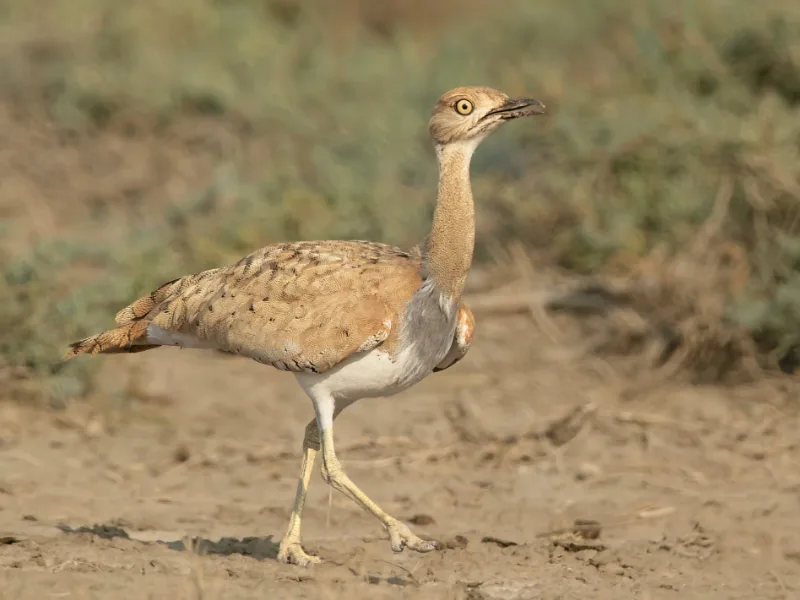
MacQueen’s bustard, also known as the Asian houbara, is the species most commonly confused with the great Indian bustard due to their overlapping ranges in India and Pakistan. However, it is smaller, lighter, and more slender, with a paler plumage that blends well with desert landscapes. Unlike the largely sedentary great Indian bustard, MacQueen’s bustard is migratory, breeding in Central Asia and wintering across the Middle East, Pakistan, and western India. It prefers sandy deserts rather than the semi-arid grasslands favored by the great Indian bustard.
Bengal florican (Houbaropsis bengalensis)
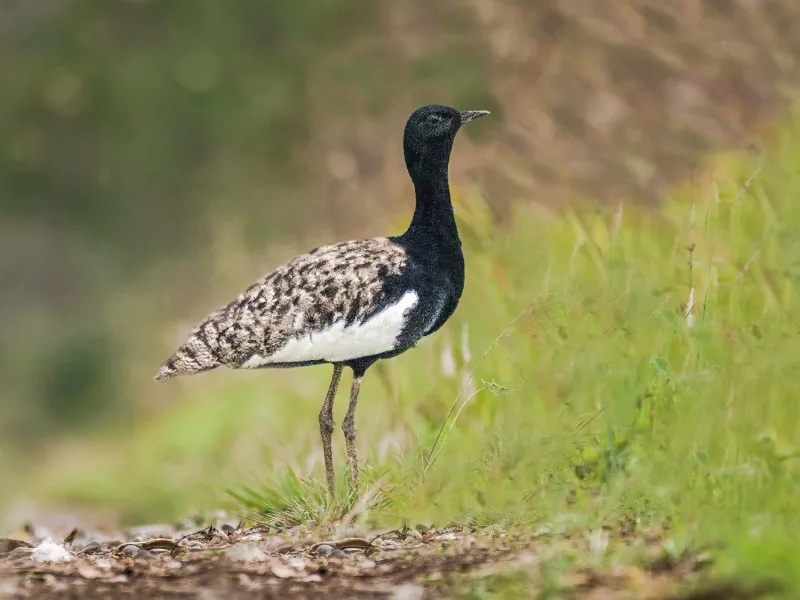
Another critically endangered species, the Bengal florican, is found in northeastern India, Nepal, and Cambodia. It is smaller and exhibits bold sexual dimorphism, with males having a striking black-and-white breeding plumage. Unlike the great Indian bustard, which inhabits dry scrublands and open plains, the Bengal florican prefers wet grasslands and floodplains.
Kori bustard (Ardeotis kori)

The kori bustard, found in Africa, is one of the largest flying birds, with males reaching 18 kg (40 lbs) or more, making it even heavier than the great Indian bustard. Both species share a terrestrial lifestyle, omnivorous diet, and reliance on camouflage, but the kori bustard inhabits African savannas, whereas the great Indian bustard is adapted to Indian grasslands and semi-arid regions.
Australian bustard (Ardeotis australis)
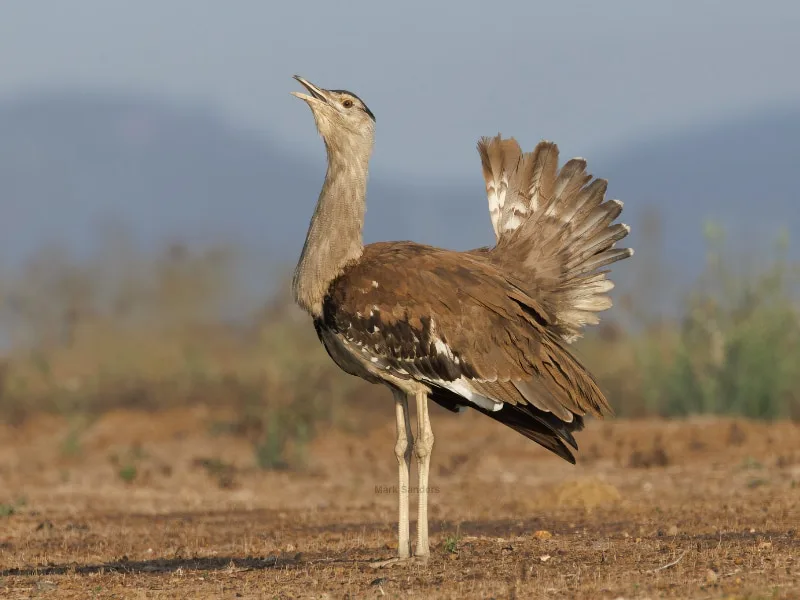
The Australian bustard, native to Australia, is slightly smaller than the great Indian bustard but shares a similar body structure and foraging behavior. Both species prefer open landscapes, rely on ground nesting, and feed on insects, seeds, and small vertebrates. While geographically distant, it remains one of the great Indian bustard’s closest relatives.
Future outlook
The great Indian bustard stands at the very edge of extinction, with fewer than 200 individuals left in the wild. Even under the most optimistic projections, the species may not survive beyond 2050 unless drastic and immediate action is taken. Habitat loss remains its greatest enemy, and while hunting has largely been curtailed, the relentless conversion of grasslands into farmland and infrastructure projects continues to shrink its last refuges.
At Planet of Birds, we are following this magnificent species closely, tracking both its struggles and the efforts to save it. We believe the great Indian bustard is more than just a critically endangered bird, it is a symbol of the vanishing grasslands and the delicate balance between human expansion and nature’s resilience. Conservationists and governments are working to protect its remaining habitats, but will it be enough? More than just preserving a species, we must fight to keep wild places wild, ensuring that the great Indian bustard remains a part of our shared natural heritage, not just a memory.
Further reading:

Well reaseatched and presented. Eye opener. Hope this article will generate awareness in protecting & encouraging bird watching tourism which is yet to get recognized.